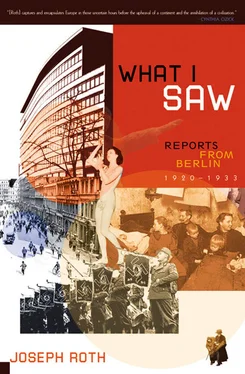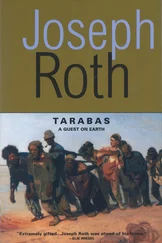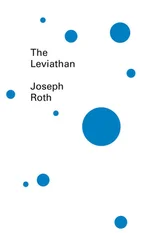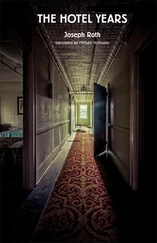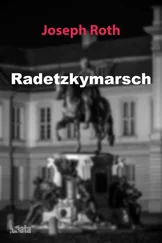Herr L. Schwarzbach,* who hails not from Ophir but from distant Drohobycz, has undertaken to rebuild the Temple of Solomon, “in miniature, of course,” as he says in his advertisement, on a scale of 1 to 70. L. Schwarzbach has worked nine full years on his construction of the Temple of Solomon. I looked at the photograph of this man who has given nine years of his life to building the temple of a deceased king, without even the prospect of an architectural diploma at the end of it. It’s the photograph of a bearded Polish Jew with velvet cap and side curls and large, dark, philosophical eyes, in which speculation stands no chance against mysticism. His picture hangs above the table on which the Temple of Solomon is exhibited. And the whole ensemble is to be found in a little Jewish restaurant on the corner of Hirtenstrasse.
Tickets to Solomon’s temple may be purchased either in the restaurant itself, or, for the more cautious, in Sternkucker’s bookstore on Grenadierstrasse. Another two marks will buy a brochure, and a further two marks will buy one in Hebrew. The literature is essential if you want to know the Temple of Solomon. Without it one would be helpless as a bridegroom.
Herr L. Schwarzbach’s Temple of Solomon is made of hard-wearing cardboard, painted in red and white and gold, and has any number of pretty doors and windows and towers and oriels, and is altogether good, true craftsmanship.† Slender little pillarets thrust upward to a thin arch they have grown expressly to support. Idiosyncratic battlements teeter aloft like little jokes of God, at the expense of this building in his praise. Green quartz windows continually prepare one for prayer, the coolness of service and confirmation. Narrow flights of stairs swarm up the heights in even and obtrusive diagonals. Little houses surprise one with their illogical presence, like boulders in the middle of a path, on the smooth parquet of a quadrangular courtyard. Alert watchtowers squinny out at the world around this restaurant table. A well, no bigger than a waistcoat button, harbors miniature deeps of water, all on a scale of 1 to 70. The whole thing, a Lilliputian institute, converts pomp into cuteness. A sweetly affecting pathos.
You may see:
the foundations, at an elevation of three hundred cubits, and five hundred cubits square, under which flows the river Kidron;
the entrance to the flower garden, “from where the scent of flowers came up into the Holy of Holies”;
the seventy-one golden chairs for the judges of the Sanhedrin;
the women’s courtyard, a square space “measuring 135 by 135 cubits”;
the chamber for the Nazarenes, where they took their pledge not to drink wine, and not to cut their hair;
the fifteen steps of the Levites, on which the fifteen psalms were sung, one psalm on every step;
the watchtower where the priests kept watch while the sacrificial fire burned;
the roof of pure gold over the Holy of Holies, studded with spikes a cubit long, to keep away bad-mannered birds;
and finally the altar, which measured 32 cubits square.
No one comes to Hirtenstrasse to see the Temple of Solomon. The people are godless and republican. In the adjacent restaurant, drying tench lie on sticky plates and stick their forked tails into the air. Sorry preserves fill a terrine with their mourning. A woman’s dress flops emptily over the back of a chair.
In the bar a group of people chew over the day’s news and the exchange rates.
They don’t talk about King Solomon the Wise, who was, I suppose, an aesthete and an eccentric. I can just see him sneaking into the “women’s courtyard, measuring 135 cubits in length and 135 cubits in breadth,” and, if there was no one watching, creeping into the flower garden to pluck an Oscar Wilde — style green carnation and pop it in his buttonhole.
Then he would have gifted the Queen of Sheba a wonderful golden roof. And in return Hiram set the bailiffs on him and made him the poorer by twenty estates. Twenty whole estates!. .
That’s how beautiful she was, the Queen of Sheba.
Neue Berliner Zeitung—12-Uhr-Blatt, October 2, 1920
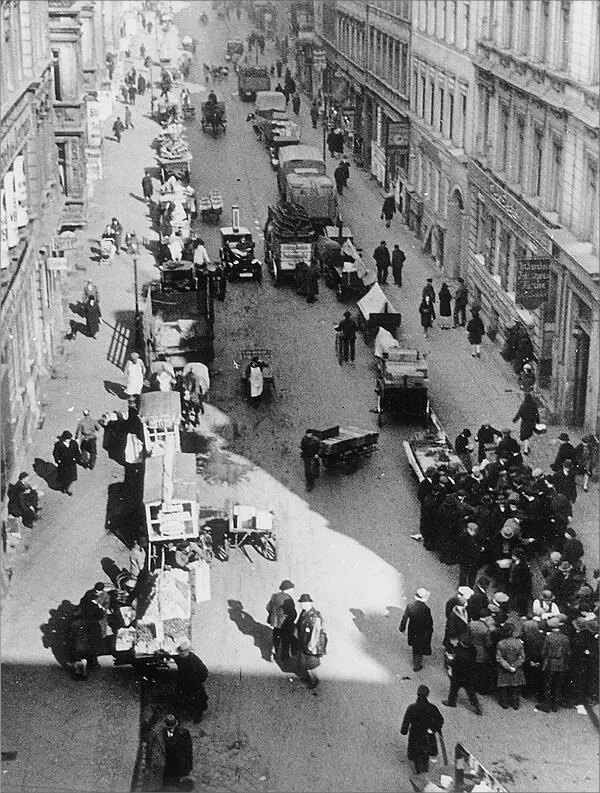
The view along Grenadierstrasse from a window on Münzstrasse.
In these days when Jews are being killed in Palestine, I chose to go to Grenadierstrasse — not to Jerusalem. I had the feeling it was better to be with the bereaved than the dead. I paid a condolence call on Grenadierstrasse. It was a hot day. All the doors were open, as were many windows. There was a reek of onions, fish, fat, and fruit, of infants, mead, wash, and sewers. The Jews were milling or walking around in Grenadierstrasse, showing a clear preference for the middle of the road over the sidewalk, and most of all for the edge of the pavement. They formed a kind of running commentary to the pavement. A kind of traffic fixture on Grenadierstrasse, cause unknown, and purpose mysterious; as if, for instance, they had been taken on by the Jewish faith to demonstrate some particular ritual. Women and children clustered in front of fruit and vegetable stands. Hebrew letters on shop signs, nameplates over doors, and in shop windows, put an end to the comely roundness of European Antiqua type with their stiff, frozen, jagged seriousness. Even though they were only doing commercial duty, they called to mind funeral inscriptions, worship, rituals, divine invocations. It was by means of these same signs that here offer herrings for sale, phonograph records, and collections of Jewish anecdotes, that Jehovah once showed himself on Mount Sinai. With the help of these terrible jagged letters he gave the Jews the first terrible moral law, for them to spread among the cheerful, blithe peoples of the world. It takes, I thought, a truly divine love to choose this people. There were so many others that were nice, malleable, and well trained: happy, balanced Greeks, adventurous Phoenicians, artful Egyptians, Assyrians with strange imaginations, northern tribes with beautiful, blond-haired, as it were, ethical primitiveness and refreshing forest smells. But none of the above! The weakest and far from loveliest of peoples was given the most dreadful curse and most dreadful blessing, the hardest law and the most difficult mission: to sow love on earth, and to reap hatred.
No! If Jews are being beaten up in Palestine, there is no need to go to Jerusalem and study the question of the British Mandate to understand why. It’s not only in Jerusalem that there is a Wailing Wall. Grenadierstrasse is one Wailing Wall after another. The punishing hand of God is clearly visible over the bent backs of the people. Of all the thousand ways that they have gone, and go, and will go, not one is a way out, not one leads to a concrete, earthly goal. No “fatherland,” no “Jewish homeland,” no “place of refuge,” no “place of liberty.” There are various opportunities to discern the so-called will of history. And nowhere does it show itself as plainly as in all the many Grenadierstrassen in which Jews don’t so much live as drift up and down. (Theirs is no pathological-degenerative unrest so much as a historically conditioned one.) Clearly it is the secret “will of history” for this people to have no country to live in but to wander the roads. And that daunting will corresponds to the daunting constitution of the Jews. In seeking a “homeland” of their own, they are rebelling against their deeper nature.
They are no nation, they are a kind of supranation, perhaps the anticipation of some future form of nation. The Jews have already lived through all the others: a state, wars, conquests, defeats. They have converted infidels with fire and sword, and many of them also have been converted to other religions, by fire and sword. They have lived through, and emerged from, their primitive periods of “national history” and “civic culture.” The only thing that was left to them is to suffer as strangers among strange peoples, because they are “different.” Their “nationalism” is of no material kind. There is not even an absolute physical identity in common; not even a fixed form of belief. The religion of their forefathers has softened into the common daily life of the descendants; it has become a way of life, of eating, of sleeping and sexual conjunction, of trading, or of working and studying. Only, the conditions of their external surroundings were more tempting and more binding than the laws that were left of their religion. It is impossible to adhere to these laws and live. And, above all the commandments of the Jewish faith, there is the supremely implacable commandment: to live. Every day demands a further concession. It’s not that they fall away from the faith of their fathers — their faith falls away from them. Or: It becomes sublimated in their descendants. It determines the way they think, act, and behave. Religiosity becomes an organic function of the individual Jew. A Jew fulfills his “religious duties,” even if he doesn’t fulfill them. Merely by being, he is religious. He is a Jew. Any other people would be required to affirm their “faith” or their “nationality.” The Jew’s affirmation is involuntary, automatic. He is marked, to the tenth generation. Wherever a Jew stops, a Wailing Wall goes up. Wherever a Jew settles down, a pogrom goes up. .
Читать дальше
